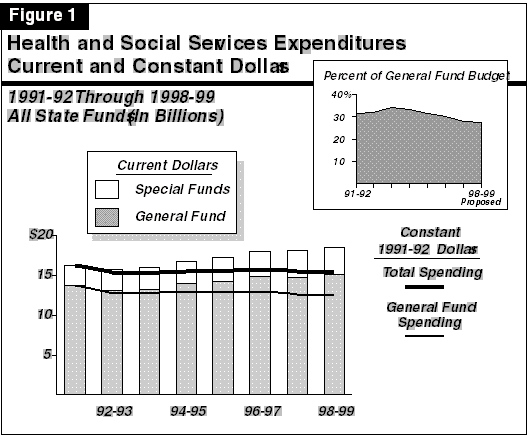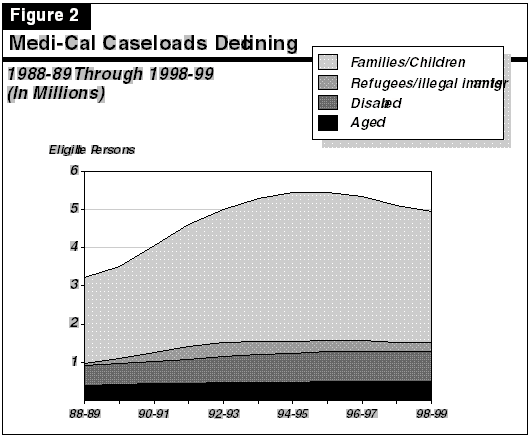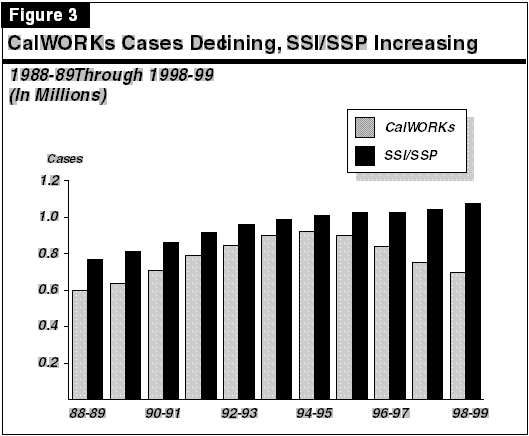We estimate that the budget proposal is more than $700 million in excess of the amount needed to fully fund CalWORKs employment services.
We recommend deleting $95 million (General Fund) proposed as the state match for the new federal Welfare-to-Work block grant because it can be deferred to future years when the match could be provided from within baseline expenditures for CalWORKs.
We recommend reducing the budget for employment services by $209 million in federal TANF block grant funds. In conjunction with separate recommendations to reduce county welfare administration by $43 million, this would free up $252 million in federal TANF block grant funds. We recommend redirecting at least half of the savings ($126 million) to a reserve for future-year CalWORKs expenditures, and we identify options for the Legislature to consider in redirecting the remaining amount. (See pages C-118 and C-120 .)
![]() Budget
Proposes to Make Permanent the CalWORKs Grant Reduction and COLA Suspension
Budget
Proposes to Make Permanent the CalWORKs Grant Reduction and COLA Suspension
The budget proposes to make permanent the 4.9 percent statewide grant reduction and the COLA suspension, for a General Fund cost avoidance of $248 million in 1998-99. Under current law, the grant reduction and COLA will be restored November 1, 1998. (See page C-116.)
![]() Budget
Proposes to Make Permanent the State COLA Suspension for the SSI/SSP
Budget
Proposes to Make Permanent the State COLA Suspension for the SSI/SSP
The budget proposal would result in a General Fund cost avoidance of $39 million in 1998-99. (See page C-148.)
![]() SSI/SSP
Caseload Growth Is Overestimated
SSI/SSP
Caseload Growth Is Overestimated
We estimate that the General Fund amount needed to fund the program is $113 million less than in the budget. (See page C-147.)
![]() Over
$200 Million of Budgeted Medi-Cal Savings Appear Arbitrary
Over
$200 Million of Budgeted Medi-Cal Savings Appear Arbitrary
In addition to specific adjustments made as a result of the transition to managed care, the Medi-Cal budget includes General Fund savings of $110 million in the current year and $133 million in 1998-99 as a result of "uncertainty adjustments" in the department's cost forecasting model. These global adjustments appear to be arbitrary. (See page C-50.)
![]() Changes
to the New Healthy Families Program Could Provide Better Coverage and Result
in Savings
Changes
to the New Healthy Families Program Could Provide Better Coverage and Result
in Savings
We recommend legislation to require children in the California Children's Services program to enroll, if eligible, in the Healthy Families program. This would provide more comprehensive health care coverage and result in an increase in federal funds and a $6.2 million reduction in state costs.
We also recommend that the administration report on the feasibility of including, as a benefit under the Healthy Families program, services provided by the regional centers for developmentally disabled children. (See page C-20.)
![]() State
Plan Amendment Would Result in General Fund Savings in the In-Home Supportive
Services (IHSS) Program
State
Plan Amendment Would Result in General Fund Savings in the In-Home Supportive
Services (IHSS) Program
Certain IHSS recipients could be made eligible for federal funds by amending our State Medicaid Plan. We recommend such an amendment, and estimate that this would result in General Fund savings of $35 million. (See page C-150.)
Figure 1 (see next page) shows that General Fund expenditures (current dollars) for health and social services programs are projected to increase by $1.4 billion, or 10 percent, between 1991-92 and 1998-99. This represents an average annual increase of 1.4 percent.
In 1991-92, realignment legislation shifted $2 billion of health and social services program costs from the General Fund to the Local Revenue Fund, which is funded through state sales taxes and vehicle license fees. This shift in funding accounted for a significant increase in special funds starting in 1991-92. General Fund spending declined in 1992-93, due to various program reductions (the largest being welfare grant reductions). The following years reflect an upward trend in spending, except for a slight reduction in 1997-98, due primarily to a decline in California Work Opportunity and Responsibility to Kids (CalWORKs, formerly Aid to Families with Dependent Children [AFDC]) program caseloads.
 Combined
General Fund and special funds spending is projected to increase by 14 percent
between 1991-92 and 1998-99. This represents an average annual increase of 1.9 percent.
Combined
General Fund and special funds spending is projected to increase by 14 percent
between 1991-92 and 1998-99. This represents an average annual increase of 1.9 percent.
Figure 1 also displays the spending for these programs adjusted for inflation (constant dollars). On this basis, General Fund expenditures are estimated to decrease by 8.7 percent between 1991-92 and 1998-99. Combined General Fund and special funds expenditures are estimated to decrease by 5.2 percent during the same period. This is an average annual decrease of less than 1 percent.
As noted previously, the 1991 realignment legislation significantly altered the financing of health and social services programs by transferring funding for all or part of several mental health, public health, and social services programs to the counties. The sales tax and vehicle license fee revenues dedicated to realignment amounted to $2 billion in 1991-92, which was $239 million short of the amount that was initially estimated. This shortfall was primarily due to the effects of the recession. The budget estimates that realignment revenues will be $2.8 billion in 1998-99.
 Medi-Cal
caseloads increased by 53 percent over the ten-year period shown in Figure 2.
As the figure shows, most of this growth occurred during the period from 1989-90
through 1994-95. The growth in the number of families and children receiving
Medi-Cal during this period reflects the rapid growth in AFDC caseloads during
this time as well as the expansion of Medi-Cal to cover additional women and
children with incomes too high to qualify for cash aid in the welfare programs.
Coverage of refugees and illegal immigrants also increased caseloads significantly
during this period. Since 1994-95, Medi-Cal caseloads have declined, including
an estimated reduction of 4.8 percent in the current year and 2.9 percent
in 1998-99, due primarily to a decline in AFDC/CalWORKs caseloads.
Medi-Cal
caseloads increased by 53 percent over the ten-year period shown in Figure 2.
As the figure shows, most of this growth occurred during the period from 1989-90
through 1994-95. The growth in the number of families and children receiving
Medi-Cal during this period reflects the rapid growth in AFDC caseloads during
this time as well as the expansion of Medi-Cal to cover additional women and
children with incomes too high to qualify for cash aid in the welfare programs.
Coverage of refugees and illegal immigrants also increased caseloads significantly
during this period. Since 1994-95, Medi-Cal caseloads have declined, including
an estimated reduction of 4.8 percent in the current year and 2.9 percent
in 1998-99, due primarily to a decline in AFDC/CalWORKs caseloads.
Figure 3 shows the caseload trend for the CalWORKs and SSI/SSP programs. While the number of cases in SSI/SSP is greater than in the CalWORKs program, there are more persons in the CalWORKs program--about 2 million compared to about 1 million for SSI/SSP. (The SSI/SSP cases are reported as individual persons, while CalWORKs cases are primarily families.)
 Caseload
growth in these two programs is due, in large part, to the growth of the eligible
target populations. The increase in the rate of growth in the AFDC/CalWORKs
caseloads in 1990-91 and 1991-92 was partly due to the effect of the recession.
During the next two years, the caseload continued to increase, but at a slower
rate of growth. This slowdown, according to the Department of Finance, was due
partly to (1) certain population changes, including lower migration from
other states; and (2) a lower rate of increase in "child-only" cases (including
citizen children of undocumented and newly legalized persons), which was the
fastest growing segment of the caseload until 1993-94. (For a discussion of
other factors affecting the AFDC caseload during this period, please see our
report on the program in The 1991-92 Budget: Perspectives and Issues,
page 189.)
Caseload
growth in these two programs is due, in large part, to the growth of the eligible
target populations. The increase in the rate of growth in the AFDC/CalWORKs
caseloads in 1990-91 and 1991-92 was partly due to the effect of the recession.
During the next two years, the caseload continued to increase, but at a slower
rate of growth. This slowdown, according to the Department of Finance, was due
partly to (1) certain population changes, including lower migration from
other states; and (2) a lower rate of increase in "child-only" cases (including
citizen children of undocumented and newly legalized persons), which was the
fastest growing segment of the caseload until 1993-94. (For a discussion of
other factors affecting the AFDC caseload during this period, please see our
report on the program in The 1991-92 Budget: Perspectives and Issues,
page 189.)
Figure 3 also shows that since 1994-95, AFDC/CalWORKs caseloads have declined. As we discuss in our report, California's Fiscal Outlook(November 1997), we believe that this trend is due largely to various factors affecting welfare caseloads, including the improving economy, lower birth rates for young women, a decline in legal immigration to California, and behavioral changes in anticipation of federal and state welfare reform.
The SSI/SSP caseload can be divided into two major components: the aged and the disabled. The aged caseload generally increases in proportion to increases in the eligible population--age 65 or older. This component accounts for about one-third of the total caseload. The larger component--the disabled caseload--has been growing faster than the rate of increase in the eligible population group (primarily ages 18 to 64). This is due to several factors, including (1) the increasing incidence of AIDS-related disabilities, (2) changes in federal policy that liberalized the criteria for establishing a disability, (3) a decline in the rate at which recipients leave the program (perhaps due to increases in life expectancy), and (4) expanded state and federal outreach efforts in the program. We note, however, that in recent years the growth of the disabled caseload has slowed.
Total SSI/SSP caseload growth has also moderated in recent years. This is partly attributable to federal policy changes that (1) eliminated drug or alcohol addiction as a qualifying disability, (2) made aged noncitizens in the U.S. prior to August 1996 (but not yet on SSI/SSP) ineligible for assistance, and (3) added restrictions on the eligibility of disabled children.
| Figure 4 | |||||
| Major Health and Welfare Programs Budget Summarya | |||||
| 1996-97 Through 1998-99
(Dollars in Millions) | |||||
| Actual
1996-97 |
Estimated
1997-98 |
Proposed
1998-99 |
Change from 1997-98 | ||
| Amount | Percent | ||||
| Medi-Cal | |||||
| General Fund | $6,838.3 | $6,780.2 | $6,819.7 | $39.5 | 0.6% |
| All Funds | 18,370.2 | 18,175.8 | 18,523.2 | 347.4 | 1.9 |
| CalWORKs (Grants and Services) | |||||
| General Fund | $2,833.8 | $2,076.2 | $1,988.4 | -$87.8 | -4.2% |
| All Funds | 5,995.0 | 5,619.1 | 5,925.9 | 306.8 | 5.5 |
| AFDC (Foster Care) | |||||
| General Fund | $307.0 | $375.4 | $399.7 | $24.3 | 6.5% |
| All Funds | 1,178.5 | 1,373.1 | 1,501.7 | 128.6 | 9.4 |
| SSI/SSP | |||||
| General Fund | $2,012.7 | $2,063.0 | $2,159.1 | $96.1 | 4.7% |
| All Funds | 5,608.0 | 5,806.2 | 6,142.1 | 335.9 | 5.8 |
| In-Home Supportive Services | |||||
| General Fund | $311.7 | $385.4 | $485.4 | $100.0 | 25.9% |
| All Funds | 1,084.1 | 1,238.6 | 1,365.2 | 126.6 | 10.2 |
| Regional Centers/Community Services | |||||
| General Fund | $458.0 | $487.8 | $578.5 | $90.7 | 18.6% |
| All Funds | 1,046.0 | 1,162.0 | 1,328.2 | 166.2 | 14.3 |
| Developmental Centers | |||||
| General Fund | $28.5 | $35.8 | $32.0 | -$3.8 | -10.6% |
| All Funds | 522.8 | 464.5 | 474.1 | 9.6 | 2.1 |
| Child Welfare Services | |||||
| General Fund | $350.0 | $448.8 | $448.5 | -$0.3 | -0.1% |
| All Funds | 1,124.0 | 1,186.0 | 1,216.8 | 30.8 | 2.6 |
| State Hospitals | |||||
| General Fund | $240.4 | $270.3 | $299.0 | $28.7 | 10.6% |
| All Funds | 479.4 | 477.4 | 484.8 | 7.4 | 1.6 |
| aExcludes departmental support, except for state hospitals. | |||||
1. The Budget Proposes to Fund Basic Caseload Growth in SSI/SSP and Reflects Savings From Basic Caseload Reductions in Medi-Cal and CalWORKs. This includes a projected caseload reduction of 2.9 percent in the Medi-Cal Program, a decrease of 5.6 percent in the CalWORKs program, and an increase of 2.1 percent in SSI/SSP (before adjusting for policy changes).
2. The Budget Proposes to Make Permanent Certain Grant Reductions and Suspension of Statutory Cost-of-Living Adjustments (COLAs). Specifically, it:
3. The Budget Funds the Full-Year Implementation Costs of the Major New Health and Welfare Programs Enacted in the Current Year.
| Figure 5 | |||||
| Health Services Programs
Proposed Major Changes for 1998-99 General Fund | |||||
| Medi-Cal | Requested: | $6.8 billion | |||
| Increase: | $40 million | (+0.6%) | |||
| +$165 million due to higher utilization of services and other cost increases | |||||
| -$102 million due to a caseload reduction | |||||
| -$66 million due to increases in the federal cost-sharing ratio | |||||
| -$44 million from full-year effect of eliminating prenatal care for undocumented persons | |||||
| Healthy Families Program | Requested: | $64 million | |||
| Increase: | $59 million | (+1,164%) | |||
| +$59 million for first full year of program implementation (includes Medi-Cal Program costs) | |||||
| Public Health | Requested: | $332 million | |||
| Increase: | $1.9 million | (+0.6%) | |||
| +$23 million to expand the Cancer Research Program | |||||
| +$16 million due to increased caseload and costs for the AIDS Drug Assistance Program | |||||
| Mental Health | Requested: | $570 million | |||
| Increase: | $17 million | (+3.1%) | |||
| +18 million for caseload growth in the state hospitals | |||||
| Figure 6 | |||||
| Social Services Programs
Proposed Major Changes for 1998-99 General Fund | |||||
| CalWORKs | Requested: | $2 billion | |||
| Decrease: | $88 million | (-4.2%) | |||
| +$1.1 billion ($79 million General Fund and $1 billion federal block grant funds) for employment services and child care | |||||
| -$248 million cost avoidance by not restoring the 4.9 percent statewide grant reduction and cost-of-living adjustment (COLA) | |||||
| -$241 million ($117 million General Fund and $124 million federal funds) from increased earnings and program exits | |||||
| -$179 million ($88 million General Fund and $91 million federal funds) due to a projected basic caseload decline | |||||
| SSI/SSP | Requested: | $2.2 billion | |||
| Increase: | $96 million | (+4.7%) | |||
| +$40 million for basic caseload growth | |||||
| +$37 million for growth in eligible disabled noncitizen caseload | |||||
| -$39 million cost avoidance by not providing the state COLA | |||||
| In-Home SupportiveServices | Requested: | $485 million | |||
| Increase: | $100 million | (+26%) | |||
| +$47 million due to reduction in federal Title XX funds | |||||
| +$30 million for full-year costs of minimum wage increase | |||||
| Regional Centers | Requested: | $579 million | |||
| Increase: | $91 million | (+19%) | |||
| +$74 million for caseload and cost increases | |||||
| +$10 million to reduce case management ratio and improve vendor services | |||||
4. The Budget Proposes to Fund Caseload Increases and Enhanced Services for Developmentally Disabled Persons. This includes $114.9 million ($94.5 million General Fund, including Medi-Cal reimbursements) for caseload and cost increases, $50.9 million ($35.2 million General Fund, including reimbursements) to enhance services for regional center clients placed in the community, and $31.1 million ($16.1 million General Fund, including reimbursements) for the first year of a four-year expansion of staffing for the developmental centers.